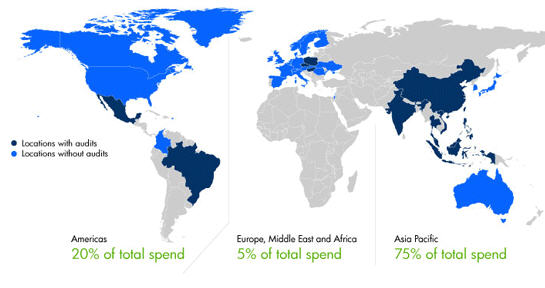HP's PC supply chain by the numbers

Hewlett-Packard's supply chain is a competitive advantage as the company aims to press its vast economies of scale. That said, HP's supply chain is very much a work in progress.
Tony Prophet, senior vice president of HP's global supply chain operations for its personal systems group unit, spoke Wednesday at an RBC Capital Markets investment conference.
Prophet's talk focused on HP's supply chain and how the company has worked to become more efficient. The transcript of the chat was notable---at least for a supply chain wonk---because it shed light on the moving parts of HP and how the company gets goods from point A to B.
Here's a look at HP's supply chain by the numbers courtesy of Prophet:
$60 billion: Sum of purchases for what Prophet calls "the world's largest IT" supply chain. That tally includes components, logistics, transportation, warehousing and services associated with the supply chain.
2: Number of PCs produced or shipped every second. Two printers are also produced or shipped every second.
15 seconds: Time it takes HP to produce or ship a server.
$50: Supply chain costs related to a PC. Prophet says supply chain costs refers to "transformation," or manufacturing, and items like transportation and duties. The cost of manufacturing and transformation in a PC is now less than the cost of memory in a computer.
70 PC supply chain sites following the HP-Compaq merger. Prophet explained that these sites---known as nodes---had inbound and outbound hubs, unique IT connections and overhead to manage the network.
30 supply chain sites in 2009 after HP whittled down its PC supply chain complexity. Prophet said: "You can see that more than concentrated in more competitive locations, cost locations. You can't see that few of them are Company-owned. And this is a blend of factories that HP owns and partner factories. But few of them are company-owned."
4 for 4: The number of so-called BRIC (Brazil, Russia, India and China) countries where HP has manufacturing capacity. Prophet said HP has expanded capacity in Brazil; India, where HP owns a facility; Russia with a plant launched this year; and China, where HP has a factory in Shanghai and western China.
2 years ago: That's when HP decided to start building plants in western China. By moving inland, HP had better access to labor, lower costs and proximity to a growing market. The first aim of this plant, which primarily makes notebooks, is to make PCs for China in China.
2: Links needed to export from China. HP is planning to export to other markets from that Western China facility. Prophet said:
We're going to work on a rail-sea link to move by rail on a relatively expedited basis to the port in Shenzhen and then by sea to the various harbors of Long Beach and Rotterdam, etc. And the second link is an air link. Air terminals that are being built (with) an expanded runway, long enough for 747 freighters that positions us to export by air or by sea from Central China.
20 days: Transit time by ocean, port to port, for a notebook made in China to hit the port at Long Beach, Calif.
39 to 40 days: Transit time by ocean, port to port, for a notebook made in China to reach Rotterdam, The Netherlands. 3 to 4 days: Time it takes for that notebook to go from a China manufacturing facility to the U.S. or Europe (including customs clearance).
450: Total supply chain nodes HP has if you were to combine the PC supply chain and distribution points with the imaging and printing business. That supply chain tally covers everything from shipping points to manufacturing facilities, warehouses and other items. Related: HP's supplier list. 10 hours: Interval between fully loaded flights of HP products out of Shanghai. This airfreight is carried on 747-400 freighters.
80 percent: That's the percentage of industry standard components in HP's industry-standard servers.
Mid- to high 90 percent: That's the percentage industry standard parts in an HP PC.
1000s: Number of rough processes in HP's supply chain across its various businesses.
25 percent: Percentage of HP supply chain processes that are shared between all supply chain activities today.
More: HP news and whitepapers and HP's supply chain sustainability report.
